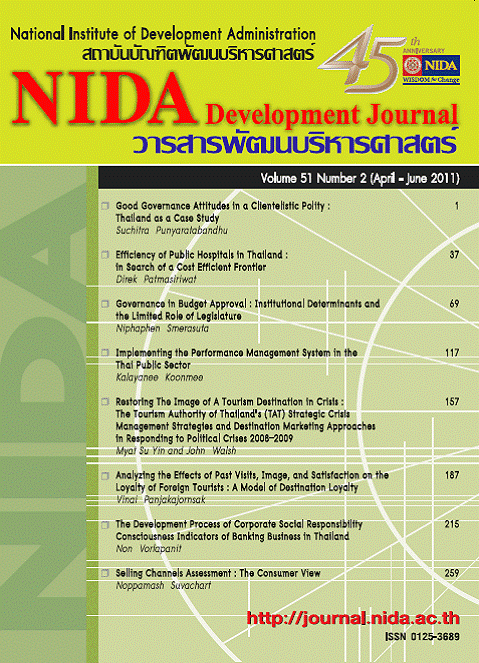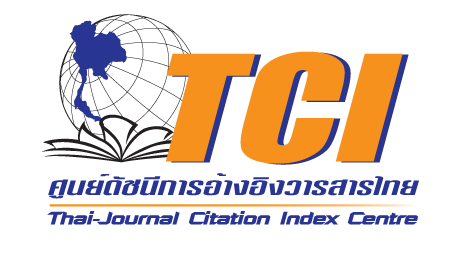Analyzing the Effects of Past Visits, Image,and Satisfaction on the Loyalty of Foreign Tourists:A Model of Destination Loyalty
Keywords:
Destination Image, Destination Satisfaction, Destination loyalty, Structural Equation ModelingAbstract
The main purpose of this study is to examine the causal relationships among past visits, image, satisfaction, and loyalty of foreign tourists to destinations in Thailand. The paper reviews the literature and identifies the observed variables used to measure the four latent constructs: past visits, image, satisfaction, and loyalty of tourists. The population of this research was 9,815,466 foreign tourists at the departure terminals in Suvarnabhumi International Airport, who were about to leave Thailand. Following Diamantopoulos and Siguaw (2000), the sample size of 360 respondents was derived from 18 variables multiplied by 20 times, and the usable number of questionnaires was 400. The research instruments used were self-administered questionnaires. The sampling technique used was simple random sampling. The results demonstrate that destination image and satisfaction had strong positive effects on destination loyalty. Further, past visits also had a positive influence on image, satisfaction, and loyalty. Destination marketers should therefore focus on designing and implementing marketing strategies and programs that improve tourist image, satisfaction, and loyalty. This paper is an attempt to fill a gap in the tourism research in Thailand by proposing and testing a causal model of destination loyalty using structural equation modeling (SEM) technique
งานวิจัยนี้มีวัตถุประสงค์หลักเพื่อสำรวจความสัมพันธ์เชิงสาเหตุระหว่างการท่องเที่ยวที่ผ่านมา ภาพลักษณ์ ความพึงพอใจ และความจงรักภักดีของนักท่องเที่ยวชาวต่างประเทศที่มาท่องเที่ยวในประเทศไทย โดยได้ทบทวนงานวิจัยที่เกี่ยวข้องเพื่อค้นหาตัวแปรสังเกตได้ที่ใช้วัดตัวแปรแฝง 4 ตัวแปร คือ การท่องเที่ยวที่ผ่านมา ภาพลักษณ์ ความพึงพอใจ และความจงรักภักดีของนักท่องเที่ยว ประชากรของการวิจัยนี้ คือ นักท่องเที่ยวชาวต่างชาติจำนวน 9,815,466 คนที่กำลังดำเนินทางออกจากประเทศไทยที่สนามบินระหว่างประเทศสุวรรณภูมิ กลุ่มตัวอย่างจำนวน 360 คน คำนวณจากคำแนะนำของ Diamantopoulos and Siguaw (2000) โดยใช้จำนวนตัวแปร 18 ตัวคูณด้วย 20 เท่า กลุ่มตัวอย่างที่เก็บและใช้ได้จริงจำนวน 400 วิธีการสุ่มตัวอย่างที่ใช้คือ การสุ่มอย่างง่าย ผลการวิจัยพบว่า ภาพลักษณ์และความพึงพอใจมีผลเชิงบวกระดับสูงต่อความจงรักภักดีของนักท่องเที่ยว นอกจากนี้ ยังพบว่า การท่องเที่ยวที่ผ่านมามีอิทธิพลต่อภาพลักษณ์ ความพึงพอใจและความจงรักภักดีของนักท่องเที่ยว ดังนั้น นักการตลาดท่องเที่ยวจึงควรกำหนดกลยุทธ์และโปรแกรมการตลาดท่องเที่ยวที่ส่งเสริมภาพลักษณ์ ความพึงพอใจ และความจงรักภักดีของนักท่องเที่ยวเพื่อทำให้นักท่องเที่ยวต้องการกลับมาเที่ยวประเทศไทยอีกในอนาคต งานวิจัยนี้เป็นความพยายามที่จะส่งเสริมการวิจัยด้านการท่องเที่ยวโดยนำเสนอและทดสอบโมเดลเชิงสาเหตุความจงรักภักดีต่อแหล่งท่องเที่ยวด้วยเทคนิคโมเดลสมการเชิงโครงสร้าง





